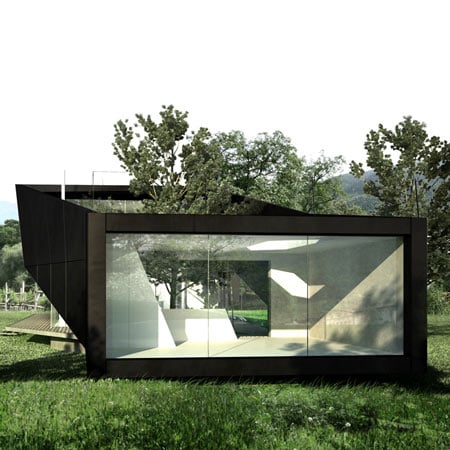Architect Peter Pichler of Bolanzo Bolzano in Italy has designed a house for a photographer with a large window at one end that doubles as a projection wall for presentations.
Created for photographer Cellina von Mannstein, the house will comprise a photography studio and living quarters, separated by an atrium around an existing tree on the site.
The two storeys of the living area will be shifted to created a terrace on the first floor at one end and a canopy over the entrance at the other.
A large window forming one end of the studio will be used as a surface for projections and presentations.
Here is some text from the architect:
The new villa for renowned photographer Cellina von Mannstein located in northern Italy is situated on a large Agricultural green surrounded by apple trees next to the established brewery Forst and the river Etsch. Surrounded by mountains, the site is part of the beginning of a main valley. It is dominated by two old walnut trees and another little river on the east side.
The main idea of the project was to keep the two trees and to capture one of the trees within the volumes of the building. The so created space is acting as a “green atrium” between those volumes and cuts the building in two parts. The two parts comprise the main housing part and a photostudio, the clients demands. The housing part is distributed on two levels which are slightly shifted on eachother to create a canopied entrance on the northern part of the first level and a balcony on the south side of the second level.
The first level contains the living area concepted as open floorplan and connects onto the south oriented terrace with pool. The entire floor is framed by a platform and is lifted up from the ground in order to guarantee a better view from the inside.
Eyecatching is the tree in the atrium, which is visible and accessible by large sliding glass windows. From the atrium you can access the photostudio on the west side, which is chracterised by a great glass facade at the end. This “screen” provides light or can alternatively be transformed into a vast projection wall (provided by an integrated projection surface) and can be used as a "drive-in-theatre" for presentations.
There is a main visual axis that goes trough the entire building from the living area until outside the photostudio. The second floor contains the sleeping area and is connected by a bridge to the top of the photostudio, which forms a large terrace.
The basement includes a parking space and is accessible from the north. The facade of the building is made of black alumium panels; it looks similar to an old and edgy camera.

